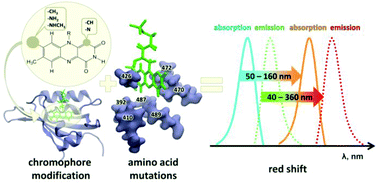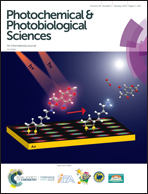Novel flavin-based fluorescent proteins with red-shifted emission bands: a computational study†
Abstract
The iLOV protein is a promising member of the class of flavin mononucleotide (FMN) based fluorescent proteins (FbFPs). It is becoming a popular tool for bioanalytical applications and bioimaging as a competitor of the well-known green fluorescent protein and its analogues. The main limitation of FbFPs is that all the members have close values of their absorption and emission band maxima. Therefore the upcoming challenge is to introduce novel variants of FbFPs to extend their color palette. We report the results of computational studies of iLOV variants, introducing point mutations and chromophore analogues. We found that point mutations of the apoprotein and substitution of FMN with either 8-amino-FMN or 8-methylamino-FMN lead to the red shift of emission bands up to 100 nm. Substitution with 1-deaza-FMN and the point mutations of the apoprotein result in a set of novel fluorescent proteins with emission bands in the “transparent” window where light readily penetrates through mammalian tissues. Newly suggested FbFPs can be used for multicolor imaging and also as components of FRET pairs.



 Please wait while we load your content...
Please wait while we load your content...